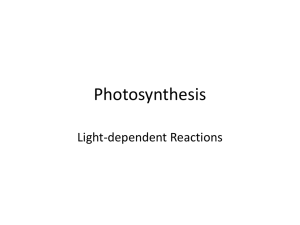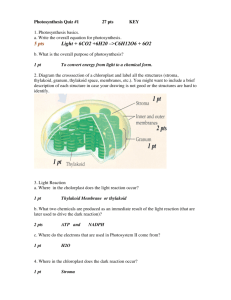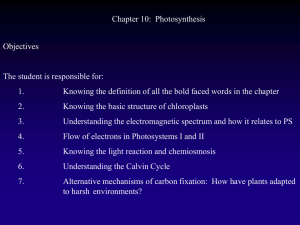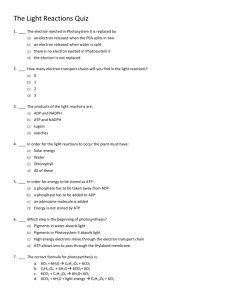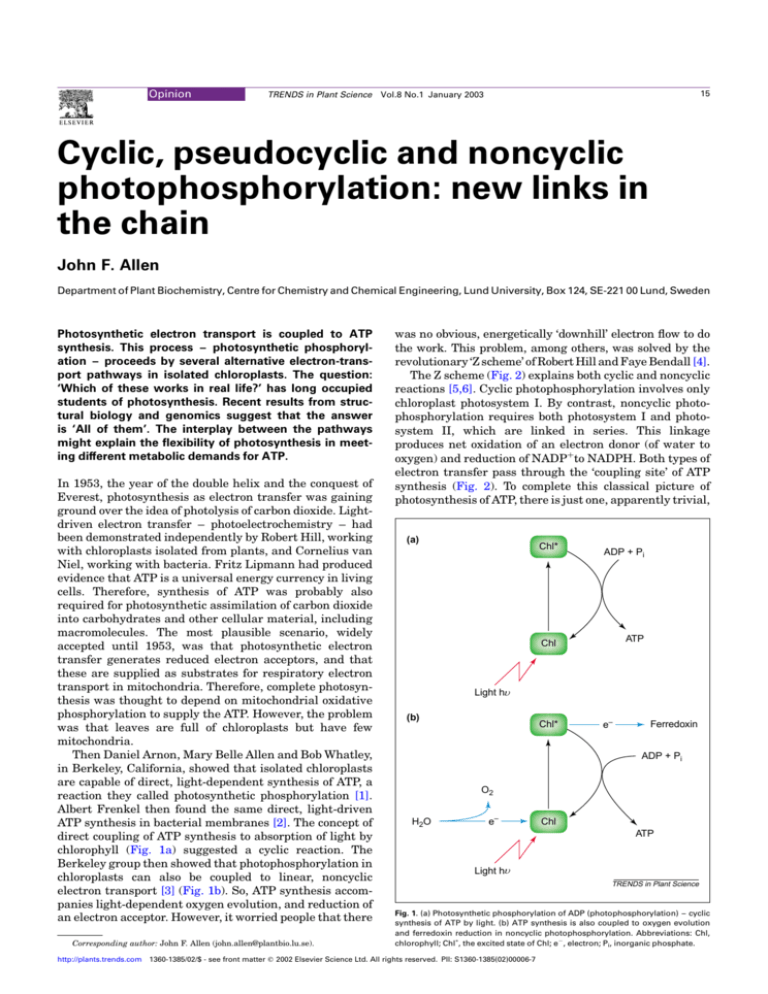
Opinion
TRENDS in Plant Science
15
Vol.8 No.1 January 2003
Cyclic, pseudocyclic and noncyclic
photophosphorylation: new links in
the chain
John F. Allen
Department of Plant Biochemistry, Centre for Chemistry and Chemical Engineering, Lund University, Box 124, SE-221 00 Lund, Sweden
Photosynthetic electron transport is coupled to ATP
synthesis. This process – photosynthetic phosphorylation – proceeds by several alternative electron-transport pathways in isolated chloroplasts. The question:
‘Which of these works in real life?’ has long occupied
students of photosynthesis. Recent results from structural biology and genomics suggest that the answer
is ‘All of them’. The interplay between the pathways
might explain the flexibility of photosynthesis in meeting different metabolic demands for ATP.
In 1953, the year of the double helix and the conquest of
Everest, photosynthesis as electron transfer was gaining
ground over the idea of photolysis of carbon dioxide. Lightdriven electron transfer – photoelectrochemistry – had
been demonstrated independently by Robert Hill, working
with chloroplasts isolated from plants, and Cornelius van
Niel, working with bacteria. Fritz Lipmann had produced
evidence that ATP is a universal energy currency in living
cells. Therefore, synthesis of ATP was probably also
required for photosynthetic assimilation of carbon dioxide
into carbohydrates and other cellular material, including
macromolecules. The most plausible scenario, widely
accepted until 1953, was that photosynthetic electron
transfer generates reduced electron acceptors, and that
these are supplied as substrates for respiratory electron
transport in mitochondria. Therefore, complete photosynthesis was thought to depend on mitochondrial oxidative
phosphorylation to supply the ATP. However, the problem
was that leaves are full of chloroplasts but have few
mitochondria.
Then Daniel Arnon, Mary Belle Allen and Bob Whatley,
in Berkeley, California, showed that isolated chloroplasts
are capable of direct, light-dependent synthesis of ATP, a
reaction they called photosynthetic phosphorylation [1].
Albert Frenkel then found the same direct, light-driven
ATP synthesis in bacterial membranes [2]. The concept of
direct coupling of ATP synthesis to absorption of light by
chlorophyll (Fig. 1a) suggested a cyclic reaction. The
Berkeley group then showed that photophosphorylation in
chloroplasts can also be coupled to linear, noncyclic
electron transport [3] (Fig. 1b). So, ATP synthesis accompanies light-dependent oxygen evolution, and reduction of
an electron acceptor. However, it worried people that there
Corresponding author: John F. Allen (john.allen@plantbio.lu.se).
was no obvious, energetically ‘downhill’ electron flow to do
the work. This problem, among others, was solved by the
revolutionary ‘Z scheme’ of Robert Hill and Faye Bendall [4].
The Z scheme (Fig. 2) explains both cyclic and noncyclic
reactions [5,6]. Cyclic photophosphorylation involves only
chloroplast photosystem I. By contrast, noncyclic photophosphorylation requires both photosystem I and photosystem II, which are linked in series. This linkage
produces net oxidation of an electron donor (of water to
oxygen) and reduction of NADPþto NADPH. Both types of
electron transfer pass through the ‘coupling site’ of ATP
synthesis (Fig. 2). To complete this classical picture of
photosynthesis of ATP, there is just one, apparently trivial,
(a)
Chl*
ADP + Pi
ATP
Chl
Light hυ
(b)
Chl*
e–
Ferredoxin
ADP + Pi
O2
H2O
e–
Chl
ATP
Light hυ
TRENDS in Plant Science
Fig. 1. (a) Photosynthetic phosphorylation of ADP (photophosphorylation) – cyclic
synthesis of ATP by light. (b) ATP synthesis is also coupled to oxygen evolution
and ferredoxin reduction in noncyclic photophosphorylation. Abbreviations: Chl,
chlorophyll; Chlp, the excited state of Chl; e2, electron; Pi, inorganic phosphate.
http://plants.trends.com 1360-1385/02/$ - see front matter q 2002 Elsevier Science Ltd. All rights reserved. PII: S1360-1385(02)00006-7
Opinion
16
TRENDS in Plant Science
Vol.8 No.1 January 2003
Ferredoxin
Chl*
e–
Chl*
e–
Ferredoxin
NADP+
Plastoquinone
Cytochrome b6
Cytochrome f
Plastocyanin
e–
O2
Chl
ADP + Pi
O2
H2O
ATP
e–
Light hυ
Chl
Light hυ
Photosystem I
Photosystem II
TRENDS in Plant Science
Fig. 2. The Z scheme for photosynthetic electron transfer encompasses ATP synthesis by cyclic (Fig. 1a) and noncyclic (Fig. 1b) photophosphorylation. Noncyclic photophosphorylation is revealed to use two photosystems, not one (Fig. 1b). In pseudocyclic photophosphorylation, the terminal electron acceptor is O2 instead of NADPþ.
Abbreviations: Chl, chlorophyll; Chlp, the excited state of Chl; e2, electron; Pi, inorganic phosphate.
addition. One of the many electron acceptors that will
work in place of NADPþ is molecular oxygen. This is
pseudocyclic electron transport, and pseudocyclic photophosphorylation. All three modes of electron transport
(cyclic, noncyclic and pseudocyclic) are coupled to ATP
synthesis (Table 1) and can readily be demonstrated in
vitro, in isolated chloroplasts.
Noncyclic photophosphorylation produces oxygen,
NADPH and ATP. Are the cyclic and pseudocyclic alternatives experimental artefacts? One view is that noncyclic electron transport is coupled to ATP synthesis with
an ATP:NADPH stoichiometry of at least 3:2 and perhaps
even 4:2 [7]. Another view is that noncyclic photophosphorylation has an ATP:NADPH ratio of 1:1, and cyclic
photophosphorylation makes extra ATP [8]. A third possibility is that extra ATP is required but that it comes from
pseudocyclic photophosphorylation [9]. Let us now fastforward, to a time of structural biology and genomics, and
see how these ideas have fared.
Stoichiometries in chemiosmotic coupling
John Walker and Paul Boyer shared part of the 1997 Nobel
Prize for Chemistry for a structural and mechanistic
breakthrough in understanding how ATP synthesis is
coupled to electron transport. The universal intermediate
in this coupling is a transmembrane electrochemical
potential gradient of hydrogen-ion concentration, the
proton-motive force of Peter Mitchell’s chemiosmotic
hypothesis (which itself won him the Nobel Prize for
Chemistry in 1978). The Walker group’s X-ray structure
[10] of beef-heart mitochondrial F1-ATPase shows a threefold rotational symmetry, with each 1208 sector containing
a different ligand-binding site associated with the catalytic
subunit, b. The shape of each site is determined by the
asymmetry of the single g subunit, which forms a ‘bearing’
inserted through the central core of the cylindrical a3b3
domain. Rotation of g within the central axis of F1 induces
sequential conformational changes in each of the three ab
heterodimers; three ATP molecules are made for each 3608
rotation of g. Several independent lines of evidence [11]
support this model, for both chloroplasts and mitochondria
[12]. Oxidative and photosynthetic phosphorylation are
not so different, after all.
The two photosystems of the Z scheme for photosynthetic electron transport (Fig. 2) have also now been
described at near-atomic resolution [13 – 16]. Connecting
the two photosystems, the chloroplast cytochrome b6f
complex is also essentially the same as its mitochondrial
counterpart (the cytochrome bc1 complex) in its fundamental features [17]. In particular, vectorial electron
transport that includes the two quinone-binding sites
and the two cytochromes b6 (the ‘Q cycle’) gives two protons
translocated for each electron transferred from photosystem II to photosystem I. Photophosphorylation works
Table 1. Properties of cyclic, noncyclic and pseudocyclic photophosphorylation
Requires photosystem I
Requires photosystem II,
inhibited by DCMU
Oxygen produced
Oxygen consumed
Electron acceptor
Cyclic
Noncyclic
Pseudocyclic
Yes
No (except to obtain redox poise)
Yes
Yes
Yes
Yes
No
No (except to obtain redox poise)
None, but cofactors include
ferredoxin, flavins, quinones,
Marmitee [5]
Yes
No
NADPþ, ferredoxin,
ferricyanide, quinones
Yes
Yes
Oxygen, via cofactors including
ferredoxin, bypyridyls
(viologens), flavins
Abbreviation: DCMU, 3-(30 ,40 -dichlorophenyl)-1,10 -dimethyl urea.
http://plants.trends.com
Opinion
TRENDS in Plant Science
17
Vol.8 No.1 January 2003
Noncyclic plus cyclic photophosphorylation
H+:ATP = 14:3 = 4.666
ATP
ATP
ATP
ATP:NADPH = 3:2 = 1.5
2NADP+
hυ :O2 = 4 + 4 + 1 = 9
Photosystem I:II = 5:4 = 1.25
ADP + Pi
ADP + Pi
14H+
12H+
O2
ADP + Pi
4e–
CF1
Photosystem I
α3β3
2H+
Fd
Fd
γ
1 rotation
Photosystem II
PQ
Cytb
4e–
HH
H
4e–
PQH2
Cytb
Fe–S
Cytf
Light 4hυ
2H2O
O2
Photosystem I
12H+
Noncyclic photophosphorylation
H H
H H H H H
Cytb
PQ
2H+
1e–
H
H
CF0
PQH2
Cytb
Fe–S
Cytf
14H+
PC
Cyt
c6
Light 4hυ
HH
NPR5?
PC
Cyt
c6
Light 1hυ
Cyclic photophosphorylation
TRENDS in Plant Science
Fig. 3. A simplified scheme for noncyclic photophosphorylation giving 12 protons translocated for every four electrons, with combined photosystem-I cyclic phosphorylation translocating two protons per electron. Stoichiometries are depicted for four electrons transferred through the noncyclic chain from H2O to NADPþand one electron
cycled through photosystem I alone. Therefore, Hþ:ATP ¼ 14 and ATP:NADPH ¼ 3:2 when noncyclic and cyclic photophosphorylation are combined. Non-cyclic photophosphorylation alone would give ATP:NADPH ¼ 9:7 (see text).; Abbreviations: cyt, cytochrome; e2, electron; Fd, ferredoxin; Pi, inorganic phosphate; PQ, plastoquinone.
because electrons move from the inner to the outer side of
the thylakoid membrane and protons are pumped in the
opposite direction, into the thylakoid lumen (Fig. 3). Apart
from leakage, or partial uncoupling, the protons move out
again only through the CFo component of the ATPase.
How does this understanding (Fig. 3) help us with the
old problem of deciding whether noncyclic photophosphorylation, by itself, makes enough ATP? If we take the
mitochondrial model for the ATPase and apply it, without
modification, to chloroplasts, we arrive at an ATP:NADPH
ratio for noncyclic phosphorylation of exactly 3:2. This is
because two electrons are required for each NADPH molecule. Four electrons passing through the complete noncyclic electron transport chain should pump 12 vectorial
protons – four released into the lumen by oxidation of
water in photosystem II, four bound at the acceptor side of
photosystem I, and eight pumped completely across the
thylakoid membrane in the Q cycle of the cytochrome b6f
complex. Twelve protons equate to one 3608 rotation of a
12-fold CFo. One 3608 rotation of CF1-g gives three ATP
molecules. Therefore, synthesis of two NADPH molecules
accompanies a single turn of CF1-g, and ATP:NADPH ¼ 3:2.
This is the worst-case scenario for devotees of cyclic and
pseudocyclic photophosphorylation – their reactions are
http://plants.trends.com
redundant. For conventional, complete photosynthesis in
C3 plants, cycles and pseudocycles are out of a job.
One foundation of this view has now been removed.
Spinach chloroplast CFo has 14-fold, not 12-fold, rotational
symmetry [18]. Even mitochondrial Fo components are far
from universally 12-fold: in yeast, they have tenfold symmetry [19]. It would be interesting to know whether the
ring size is under physiological, developmental or genetic
control, as it might be in E. coli [20]. However, let us now
recalculate (Fig. 3). The 12 protons transported by four
electrons in the non-cyclic chain must drive a 14-fold CFo
through 12 of its 14 steps. This will give six-sevenths of a
rotation, or 3088. The true ATP:NADPH ratio of noncyclic
phosphorylation is then (3/2) £ (6/7), or 9:7. In decimal
form, and rounded up to seven places, this is 1.2857143.
This value would have seemed absurd in the days when it
was thought that there were chemical intermediates in
photosynthetic and oxidative phosphorylation. An integer
was taken for granted, and there were high stakes on
whether the answer was one or two. Even 3:2 was regarded
as a facile compromise, with no obvious mechanistic basis.
So it seems that something has to supply the additional
ATP for CO2 fixation by the Benson – Calvin pathway,
which requires ATP:NADPH ¼ 3:2. If the answer is
18
Opinion
TRENDS in Plant Science
Vol.8 No.1 January 2003
Box 1. Redox poise
The velocity, v, of any simple, first-order electron transfer will be
proportional to the product of the activities of the donor and acceptor.
v a ½donor £ ½acceptor
Over-oxidized
Poised
Over-reduced
Maximum
Consider a component Q of a cyclic chain. The velocity will be given by:
v a ½Qred £ ½Qox However, Q is either reduced, Qred, or it is oxidized, Qox.
Qred þ Qox ¼ 1
[Qox ¼ 1 2 Qred
Substituting, and omitting square brackets to approximate activity as
concentration,
v
v a Qred £ ð1 2 Qred Þ
2
[v=C ¼ Qred 2 Qred
where C is a constant of proportionality. This is the equation of a
parabola (Fig. I).
Thus, v is at a maximum when Qred ¼ 0.5 (i.e. when Q is 50% oxidized
and 50% reduced). When Q is completely reduced (Qred ¼ 1) or
completely oxidized (Qred ¼ 0), v ¼ 0. This analysis was originally
suggested by J. Bennett (pers. commun.).
0
0
0.5
1.0
Qred/Q
TRENDS in Plant Science
Fig. I.
pseudocyclic electron transport, 14% of electrons must end
up on oxygen and not on NADPþ. If the answer is cyclic
electron transport and cyclic electron transport pumps two
protons for each electron (through the Q cycle operating
alone), photosystem I must recycle one electron in five
(Fig. 3). For maximum efficiency, this would mean that
there is 20% more photosystem I than photosystem II. This
conclusion is in agreement with recent estimates [21].
Perhaps the CFo ring size of 14 is not as anomalous as it
first appears.
Poised for action
Cyclic photophosphorylation requires a balance in its
input and output of electrons (Box 1). Cyclic electron
transport is zero when its components are completely
reduced because there is nowhere for the electrons to go.
Similarly, cyclic electron transport is zero when its components are completely oxidized because there are no
electrons to cycle [22]. Photosynthetic systems seem to be
obsessed with avoiding these two extremes. Pure kinetics
(Box 1), post-translational modification [23– 25] and even
redox control of reaction-centre gene expression [26] are
all deployed to maintain a poised plastoquinone pool. In
spite of these control mechanisms, over-reduction is
expected when the Benson – Calvin cycle is unable to use
NADPH, and one reason for this is insufficient ATP.
Therefore, if cyclic phosphorylation is required for the
Benson – Calvin cycle to regenerate an electron acceptor
(NADPþ) for noncyclic electron transport, then failure of
cyclic electron transport will cause the whole system to
stall – the surplus electrons from NADPH will have
http://plants.trends.com
nowhere to go. A poising pulse of oxygen to bleed off
surplus electrons and compensate for an over-reduced
chain is sufficient to kick-start whole photosynthesis by
restoring redox poise, allowing cyclic electron transport to
generate the extra ATP required for the Benson – Calvin
cycle to oxidize NADPH. Poising is thus a plausible
function for pseudocyclic electron transport [27,28].
New genes for new components
Chlorophyll fluorescence emission at room temperature
represents light energy that is re-emitted because photosystem II is unable to convert it photochemically. One
factor that influences the yield of fluorescence is a protein,
psbS, that seems to be required to dispose of excess energy
at high light intensities by thermal or non-radiative decay
[29]. The downregulation of photosystem II produced by
psbS correlates with decreased pH in the thylakoid lumen.
Cyclic electron flow around photosystem I establishes a pH
gradient (DpH) and might help to dissipate excess energy
in photosystem II [27]. It is possible that a DpH above a
certain threshold is a switch to dissipate an unusable
proportion of the light absorbed by chlorophyll molecules
of photosystem II. However, restricting electron flow into
the cyclic chain increases the rate of cyclic phosphorylation
if it is otherwise limited by over-reduction.
Another gene required for efficient photosynthesis is
described by Munekage and co-workers [30]. The predicted
protein is termed PGR5, for proton gradient regulation. The
pgr5 mutant phenotype is one of decreased photosystem-I
cyclic electron transport, as shown by its inability to increase
fluorescence yield when NADPH and ferredoxin are added
Opinion
TRENDS in Plant Science
to thylakoids. In normal thylakoids, the plastoquinone
pool becomes reduced and fluorescence rises because
photosystem II has nowhere to send electrons, indicating
an electron-transport pathway from ferredoxin to plastoquinone, just as required by the cyclic chain. If cyclic
photophosphorylation is required for normal photosynthetic growth, the pgr5 mutant is expected to have found
an alternative source of extra ATP. Possibilities include
constitutive pseudocyclic phosphorylation and a decreased
CFo ring size. Perhaps the general function of a combined
cyclic and noncyclic photophosphorylation is to permit
flexibility in the ATP:NADPH ratio according to metabolic
demands. The pgr5 mutant would then be expected to be a
poor adaptor to changes such as altered nitrogen supply.
Ammonium assimilation requires mostly ATP for glutamine-synthetase activity, whereas nitrate or nitrate
assimilation requires electrons from ferredoxin, and
noncyclic electron transport.
The PGR5 protein is membrane bound but it does not
have an extensive hydrophobic sequence, which suggests
that it is not intrinsic to the thylakoid. Nor does PGR5
have any obvious motif suggesting a redox-active prosthetic group. PGR seems to be a candidate for the longsought ferredoxin – quinone oxidoreductase [31] that must
exist in some form if cyclic photophosphorylation is a
reality. However, PGR5 is thought to have a role in electron
transport from ferredoxin – NADPþoxidoreductase to the
cytochrome b6f complex [30]. A functional association
between these two complexes has been indicated [32]. In
contrast to PGR5, cytochrome c6 is a well-characterized
electron carrier. For many years, cytochrome c6 was thought
to be exclusive to cyanobacteria, but its gene is present in
Arabidopsis [33] and it is now known to function as an
alternative to plastocyanin in chloroplasts [34]. Another
factor to be considered is the chloroplast-encoded NAD(P)H
dehydrogenase subunits revealed by plastid genome
sequencing [30]. These might represent a ‘long cycle’
around photosystem I but their role in classical cyclic
photophosphorylation is unclear. One function for a chloroplast NAD(P)H dehydrogenase might be to add electrons
to the cyclic chain to produce poise and ATP synthesis
when photosystem II is switched off by non-photochemical
quenching or photoinhibition.
Therefore, all three modes of photosynthetic phosphorylation – cyclic, non-cyclic and pseudocyclic – are likely to be
at work in vivo. Although the original distinction between
oxidative and photosynthetic phosphorylation still holds,
there is a fundamental unity in the mechanism of energy
coupling and in the structures of the generators and
consumers of the proton-motive force. What makes photosynthesis special is the way in which the electrons are set
in motion in the first place, and its need to adapt to wideranging quantities and quality of light.
References
1 Arnon, D.I. et al. (1954) Photosynthesis by isolated chloroplasts.
Nature 174, 394– 396
2 Frenkel, A. (1954) Light induced phosphorylation by cell-free
preparations of photosynthetic bacteria. J. Am. Chem. Soc. 76,
5568 – 5569
http://plants.trends.com
Vol.8 No.1 January 2003
19
3 Arnon, D.I. et al. (1957) Triphosphopyridine nucleotide as a catalyst of
photosynthetic phosphorylation. Nature 180, 182 – 185
4 Hill, R. and Bendall, F. (1960) Function of the two cytochrome components in chloroplasts – a working hypothesis. Nature 186, 136 – 137
5 Walker, D.A. (2002) The Z-scheme – down hill all the way. Trends Plant
Sci. 7, 183 – 185
6 Zerges, W. (2002) Does complexity constrain organelle evolution?
Trends Plant Sci. 7, 175– 182
7 Heathcote, P. and Hall, D.O. (1974) Photosynthetic control and photophosphorylation in photosystem II of isolated spinach chloroplasts.
Biochem. Biophys. Res. Commun. 56, 767 – 774
8 Arnon, D.I. (1984) The discovery of photosynthetic phosphorylation.
Trends Biochem. Sci. 9, 258 – 262
9 Allen, J.F. (1975) Oxygen reduction and optimum production of ATP in
photosynthesis. Nature 256, 599 – 600
10 Abrahams, J.P. et al. (1994) Structure at 2.8 Å resolution of F1-ATPase
from bovine heart mitochondria. Nature 370, 621 – 628
11 Junge, W. (1999) ATP synthase and other motor proteins. Proc. Natl
Acad. Sci. U.S.A. 96, 4735 – 4737
12 McCarty, R.E. et al. (2000) The chloroplast ATP synthase: a rotary
enzyme? Annu. Rev. Plant Physiol. Plant Mol. Biol. 51, 83 – 109
13 Zouni, A. et al. (2001) Crystal structure of photosystem II from
Synechococcus elongatus at 3.8 Å resolution. Nature 409, 739– 743
14 Jordan, P. et al. (2001) Three-dimensional structure of cyanobacterial
photosystem I at 2.5 Å resolution. Nature 411, 909 – 917
15 Blankenship, R.E. (2002) Molecular Mechanisms of Photosynthesis,
Blackwell Science
16 Heathcote, P. et al. (2002) Reaction centres: the structure and evolution of biological solar power. Trends Biochem. Sci. 27, 79 – 87
17 Berry, E.A. et al. (2000) Structure and function of cytochrome bc
complexes. Annu. Rev. Biochem. 69, 1005– 1075
18 Seelert, H. et al. (2000) Structural biology. Proton-powered turbine of a
plant motor. Nature 405, 418 – 419
19 Stock, D. et al. (2000) The rotary mechanism of ATP synthase. Curr.
Opin. Struct. Biol. 10, 672 – 679
20 Schemidt, R.A. et al. (1998) Effects of carbon source on expression of F0
genes and on the stoichiometry of the c subunit in the F1F0 ATPase of
Escherichia coli. J. Bacteriol. 180, 3205– 3208
21 Albertsson, P. (2001) A quantitative model of the domain structure of
the photosynthetic membrane. Trends Plant Sci. 6, 349 – 358
22 Whatley, F.R. (1995) Photosynthesis by isolated chloroplasts: the early
work in Berkeley. Photosynth. Res. 46, 17 – 26
23 Allen, J.F. and Forsberg, J. (2001) Molecular recognition in thylakoid
structure and function. Trends Plant Sci. 6, 317– 326
24 Wollman, F.A. (2001) State transitions reveal the dynamics and
flexibility of the photosynthetic apparatus. EMBO J. 20, 3623– 3630
25 Finazzi, G. et al. (2002) Involvement of state transitions in the switch
between linear and cyclic electron flow in Chlamydomonas reinhardtii.
EMBO Rep. 3, 280 – 285
26 Pfannschmidt, T. et al. (1999) Photosynthetic control of chloroplast
gene expression. Nature 39, 625 – 628
27 Heber, U. and Walker, D. (1992) Concerning a dual function of coupled
cyclic electron transport in leaves. Plant Physiol. 100, 1621– 1626
28 Heber, U. (2002) Irrungen, Wirrungen? The Mehler reaction in
relation to cyclic electron transport in C3 plants. Photosynth. Res.
73, 223 – 231
29 Li, X.P. et al. (2000) A pigment-binding protein essential for regulation
of photosynthetic light harvesting. Nature 403, 391 – 395
30 Munekage, Y. et al. (2002) PGR5 is involved in cyclic electron flow
around photosystem I and is essential for photoprotection in
Arabidopsis. Cell 110, 361– 371
31 Bendall, D.S. and Manasse, R.S. (1995) Cyclic photophosphorylation
and electron transport. Biochim. Biophys. Acta Bioenerg. 1229, 23 – 38
32 Zhang, H. et al. (2001) Ferredoxin:NADPþ oxidoreductase is a subunit
of the chloroplast cytochrome b6f complex. J. Biol. Chem. 276,
38159 – 38165
33 Wastl, J. et al. (2002) Higher plants contain a modified cytochrome c6.
Trends Plant Sci. 7, 244 – 245
34 Gupta, R. et al. (2002) Functional relationship of cytochrome c6 and
plastocyanin in Arabidopsis. Nature 417, 567– 571



